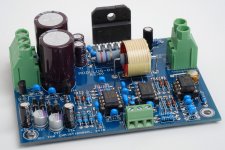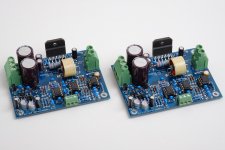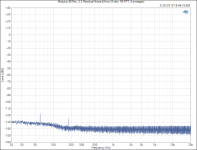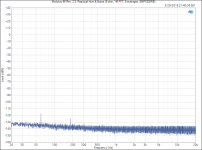Thanks for the email Tom. I've ordered another Mod-86.
I still can't believe that I made such a mistake that could have been easily avoided by a blind man if only he were paying attention.
As always, appreciate your time in trouble shooting and support.
I still can't believe that I made such a mistake that could have been easily avoided by a blind man if only he were paying attention.
As always, appreciate your time in trouble shooting and support.
You're welcome. And thanks for your order.
Ya know... It could be worse. Nothing caught on fire or exploded. 🙂
Tom
Ya know... It could be worse. Nothing caught on fire or exploded. 🙂
Tom
Rev. 2.3 boards arrived via FedEx yesterday.
Rev. 2.3 uses the THAT1200 for the differential receiver, LME49720 for the error correction circuit, OPA2277 for the DC servo, and LM3886 for output power. All parts are through hole (PTH, leaded) parts for easy of DIYing.
The unused channel in the LME49720 is configured as a buffer with its input tied to ground. Within the audio band, Rev. 2.3 is identical to Rev. 2.2. Outside the audio band there are two changes: I added a pole in the EMI/RFI filter, so Rev. 2.3 has a bit better EMI/RFI immunity. Also, I used my newfangled custom wound inductor in the Thiele Network (output L||R). This makes the Thiele Network a lot easier to assemble and also allows folks to purchase the inductors ready made if they desire.
The documentation will undergo a major rewrite as it's getting a bit long in the tooth. My plan is to tighten it up and make it easier to find the relevant information while also provide sufficient detail on the inner workings of the circuit that folks can appreciate the engineering behind it.
The first boards shipped today and I expect to have the documentation ready by the time they reach their destination.
Tom
Rev. 2.3 uses the THAT1200 for the differential receiver, LME49720 for the error correction circuit, OPA2277 for the DC servo, and LM3886 for output power. All parts are through hole (PTH, leaded) parts for easy of DIYing.
The unused channel in the LME49720 is configured as a buffer with its input tied to ground. Within the audio band, Rev. 2.3 is identical to Rev. 2.2. Outside the audio band there are two changes: I added a pole in the EMI/RFI filter, so Rev. 2.3 has a bit better EMI/RFI immunity. Also, I used my newfangled custom wound inductor in the Thiele Network (output L||R). This makes the Thiele Network a lot easier to assemble and also allows folks to purchase the inductors ready made if they desire.
The documentation will undergo a major rewrite as it's getting a bit long in the tooth. My plan is to tighten it up and make it easier to find the relevant information while also provide sufficient detail on the inner workings of the circuit that folks can appreciate the engineering behind it.
The first boards shipped today and I expect to have the documentation ready by the time they reach their destination.
Tom
Attachments
Tom,
Nice looking boards you got there, and good to see you making improvements on the high performance Modulus-86 design with each iteration.
I'm enjoying my Mod-86 stereo amp on a regular basis. Wish you success with your latest rev. 🙂
Nice looking boards you got there, and good to see you making improvements on the high performance Modulus-86 design with each iteration.
I'm enjoying my Mod-86 stereo amp on a regular basis. Wish you success with your latest rev. 🙂
Rev. 2.3 boards arrived via FedEx yesterday.
Rev. 2.3 uses the THAT1200 for the differential receiver, LME49720 for the error correction circuit, OPA2277 for the DC servo, and LM3886 for output power. All parts are through hole (PTH, leaded) parts for easy of DIYing.
The unused channel in the LME49720 is configured as a buffer with its input tied to ground. Within the audio band, Rev. 2.3 is identical to Rev. 2.2. Outside the audio band there are two changes: I added a pole in the EMI/RFI filter, so Rev. 2.3 has a bit better EMI/RFI immunity. Also, I used my newfangled custom wound inductor in the Thiele Network (output L||R). This makes the Thiele Network a lot easier to assemble and also allows folks to purchase the inductors ready made if they desire.
The documentation will undergo a major rewrite as it's getting a bit long in the tooth. My plan is to tighten it up and make it easier to find the relevant information while also provide sufficient detail on the inner workings of the circuit that folks can appreciate the engineering behind it.
The first boards shipped today and I expect to have the documentation ready by the time they reach their destination.
Tom
Is there a preassembled option? I am running behind on all the work an excitement...
Is there a preassembled option? I am running behind on all the work an excitement...
I have two in stock right now. They're on my website. Once they're gone, I'll probably remove the "fully assembled" option. I need to use these for my own testing, so whoever ends up buying will get the best characterized Modulus-86 R2.3 around. 🙂
I plan to keep the MOD86 going as a DIY product for as long as practically possible. I'll nudge those who prefer fully assembled modules in the direction of the Modulus-286 R2.0 (when available) and Modulus-686.
Tom
Since I was measuring the Modulus-86 Rev. 2.3 anyway, I thought I'd address a few common questions regarding the MOD86 and switching power supplies.
Below are the THD+N vs output power for my HP 6643A lab supply (actually two of them to form ±30 V) and the Connex Electronic SMPS300RE. If anything, the performance with the SMPS300RE is actually better than with the well-regulated power supply.
The plots that do not show the power supply in the title are with the HP lab supply.
Another common question is the damping factor. For Rev. 2.3, it's a bit over 1900 at 1 kHz. Drops to 660 at 20 kHz.
Rev. 2.2 and below should have slightly lower DF as they use more turns in the output inductor. If I was to guess, I'd estimate a DF around 400 (20 kHz); 1200 (1 kHz) for those.
Needless to say, your speaker cables and connectors will have a greater influence on the DF than the amp.
Tom
Below are the THD+N vs output power for my HP 6643A lab supply (actually two of them to form ±30 V) and the Connex Electronic SMPS300RE. If anything, the performance with the SMPS300RE is actually better than with the well-regulated power supply.
The plots that do not show the power supply in the title are with the HP lab supply.
Another common question is the damping factor. For Rev. 2.3, it's a bit over 1900 at 1 kHz. Drops to 660 at 20 kHz.
Rev. 2.2 and below should have slightly lower DF as they use more turns in the output inductor. If I was to guess, I'd estimate a DF around 400 (20 kHz); 1200 (1 kHz) for those.
Needless to say, your speaker cables and connectors will have a greater influence on the DF than the amp.
Tom
Attachments
-
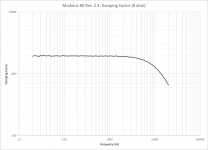 Modulus-86_R2p3_DampingFactor.png63.7 KB · Views: 141
Modulus-86_R2p3_DampingFactor.png63.7 KB · Views: 141 -
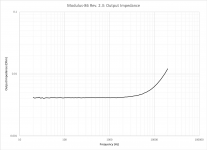 Modulus-86_R2p3_OutputImpedance.png60 KB · Views: 154
Modulus-86_R2p3_OutputImpedance.png60 KB · Views: 154 -
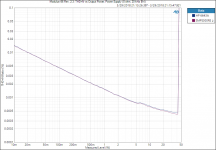 Modulus-86 Rev. 2.3_ THD+N vs Output Power, Power Supply (8 ohm, 20 kHz BW).PNG50.4 KB · Views: 153
Modulus-86 Rev. 2.3_ THD+N vs Output Power, Power Supply (8 ohm, 20 kHz BW).PNG50.4 KB · Views: 153 -
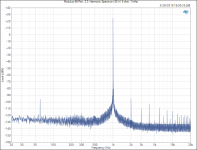 Modulus-86 Rev. 2.3_ Harmonic Spectrum (40 W, 8 ohm, 1 kHz).PNG51.3 KB · Views: 148
Modulus-86 Rev. 2.3_ Harmonic Spectrum (40 W, 8 ohm, 1 kHz).PNG51.3 KB · Views: 148 -
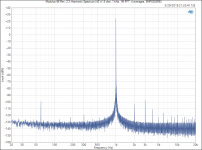 Modulus-86 Rev. 2.3_ Harmonic Spectrum (40 W, 8 ohm, 1 kHz, 1M FFT, 4 averages, SMPS300RE).PNG57.6 KB · Views: 157
Modulus-86 Rev. 2.3_ Harmonic Spectrum (40 W, 8 ohm, 1 kHz, 1M FFT, 4 averages, SMPS300RE).PNG57.6 KB · Views: 157 -
 Modulus-86 Rev. 2.3_ Harmonic Spectrum (1 W, 8 ohm, 1 kHz, 1M FFT, 4 averages).PNG51.1 KB · Views: 462
Modulus-86 Rev. 2.3_ Harmonic Spectrum (1 W, 8 ohm, 1 kHz, 1M FFT, 4 averages).PNG51.1 KB · Views: 462 -
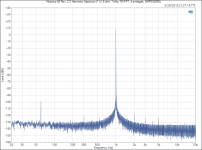 Modulus-86 Rev. 2.3_ Harmonic Spectrum (1 W, 8 ohm, 1 kHz, 1M FFT, 4 averages, SMPS300RE).png56.4 KB · Views: 492
Modulus-86 Rev. 2.3_ Harmonic Spectrum (1 W, 8 ohm, 1 kHz, 1M FFT, 4 averages, SMPS300RE).png56.4 KB · Views: 492
As most of you know, output impedances of most dynamic loudspeakers hit nadirs below 1khz. Typically less than 500Hz. Given that we are talking about damping factors of 1200-1900 I am now all too certain that I sold my recent thru hole Modulus 86 for all too little unfortunately.
A damping factor of 1900 is 4.2 milliohms and 1200 is 6.66 milliohms folks.
Great work Tom as always!
Best,
Anand
A damping factor of 1900 is 4.2 milliohms and 1200 is 6.66 milliohms folks.
Great work Tom as always!
Best,
Anand
Thank you.
Just dawned on me that I forgot to attach the residual hum & noise plots.
The total integrated noise and hum measures 32 uV (A-weighted); 40 uV (unweighted). Same as the other Modulus-86 Rev. 2.x versions.
Tom
Just dawned on me that I forgot to attach the residual hum & noise plots.
The total integrated noise and hum measures 32 uV (A-weighted); 40 uV (unweighted). Same as the other Modulus-86 Rev. 2.x versions.
Tom
Attachments
Thanks Tom! Just finished the amp this weekend. Bought the boards many months ago, only recently realizing the lme49710 stocks were dwindling fast. Glad I completed now. I'm absolutely lovin' it.
Currently have a makeshift volume control connected it, while I'm waiting for some pcbs to come in for single ended preamp that will go through your THAT driver.
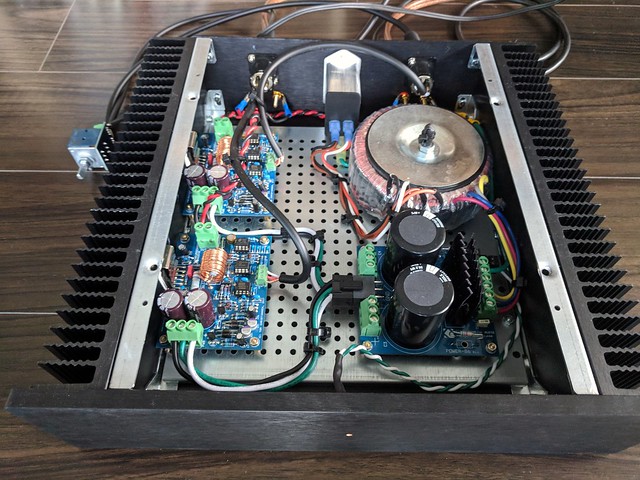
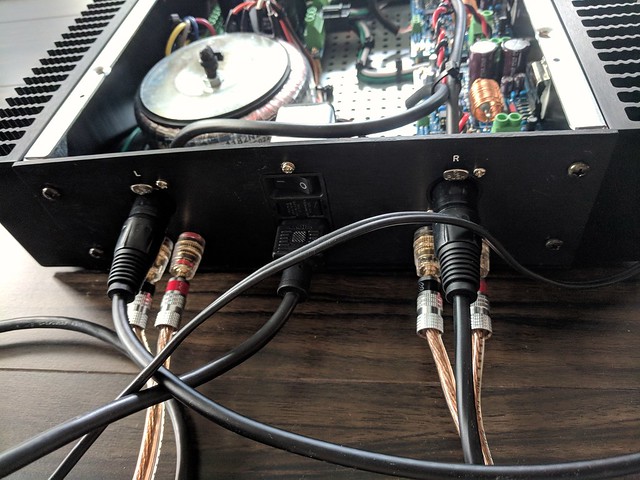
Currently have a makeshift volume control connected it, while I'm waiting for some pcbs to come in for single ended preamp that will go through your THAT driver.


Dang! Nicely done. Is that the 2U Mini Dissipante by any chance? What size transformer? 100 VA? 200 VA?
I've often wanted to make a build exactly like that. It would make a really neat kit.
Tom
I've often wanted to make a build exactly like that. It would make a really neat kit.
Tom
Yes, that's a Mini Dissipante 2U. Transformer is the 160VA Hammond 1182n22, as the Antek AS2222 has been out of stock.
Dang! Nicely done. Is that the 2U Mini Dissipante by any chance? What size transformer? 100 VA? 200 VA?
I've often wanted to make a build exactly like that. It would make a really neat kit.
Tom
What Depth of Mini Dissipante 2U? I was looking at that enclosure and the 250 mm depth looks a little tight.
Actually, I got mine direct from Modushop. They have a 300mm depth offering, which is what I used.
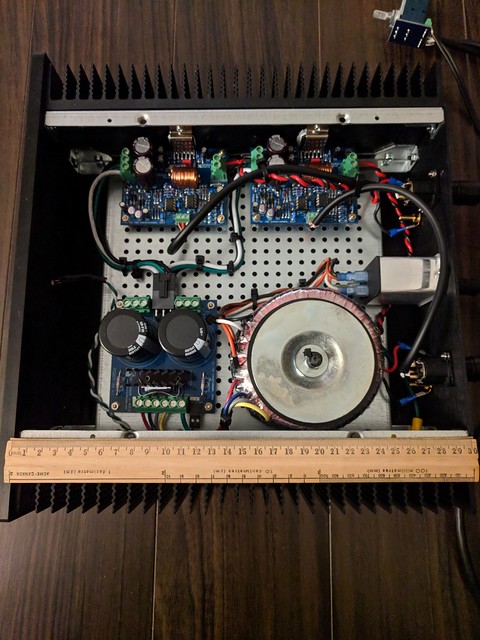

Currently have a makeshift volume control connected it, while I'm waiting for some pcbs to come in for single ended preamp that will go through your THAT driver.
blackskull,
Nice work there with your Modulus-86 build.
Btw, I am using Tom's THAT Driver as a preamp and very happy with it.
Last edited:
Yes, THD and noise. Between miniDSP and a well made analog xover using LM 4562, there is about 20 dB difference. Not that miniDSP is bad, not at all, it is very good. But not the same ballpark as the Modulus86.
I have measured these differences time and again. These are Q&D (quick and dirty) measurements comparing the mid section of a xover.
This is the miniDSP
View attachment 482589
As compared to the analog version
View attachment 482588
Please notice that for the analog version, I had to use a 15 dB scale compared to the 10 dB scale for the miniDSP.
A more recent analog xover I assembled has even better performance (because of better lay out etc.)
Besides the quality of the DACs (i prefer r2r), I see that my reserves against using the miniDSP (or similar products) were justified.
Last edited:
- Home
- Amplifiers
- Chip Amps
- Modulus-86 build thread
